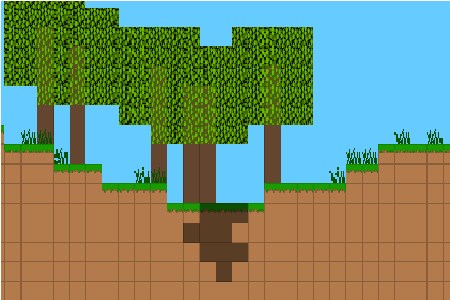Hi guys , i wan’t to ask you something about perlin noise generation in defold, i’ve already try to work on it but i don’t understand how it work ! So, i want to create a game with the generation like terraria starbound or crea, i understand that i need to play with the 1D perlin noise generation, i tried it but that gives me some wierd things. Maybe i have not understand very well the principle of the perlin noise, and that is why i am asking to you if you can explain me simply how it really work (because i am not english and i have not a really good english.
the perlin noise i used look like this :
-- https://stackoverflow.com/questions/33425333/lua-perlin-noise-generation-getting-bars-rather-than-squares
-- original code by Ken Perlin: http://mrl.nyu.edu/~perlin/noise/
local function BitAND(a,b)--Bitwise and
local p,c=1,0
while a>0 and b>0 do
local ra,rb=a%2,b%2
if ra+rb>1 then c=c+p end
a,b,p=(a-ra)/2,(b-rb)/2,p*2
end
return c
end
local function fade( t )
return t * t * t * (t * (t * 6 - 15) + 10)
end
local function lerp( t, a, b )
return a + t * (b - a)
end
local function grad( hash, x, y, z )
local h = BitAND(hash, 15)
local u = h < 8 and x or y
local v = h < 4 and y or ((h == 12 or h == 14) and x or z)
return ((h and 1) == 0 and u or -u) + ((h and 2) == 0 and v or -v)
end
local perlin = {
p = {},
permutation = { 151,160,137,91,90,15,
131,13,201,95,96,53,194,233,7,225,140,36,103,30,69,142,8,99,37,240,21,10,23,
190, 6,148,247,120,234,75,0,26,197,62,94,252,219,203,117,35,11,32,57,177,33,
88,237,149,56,87,174,20,125,136,171,168, 68,175,74,165,71,134,139,48,27,166,
77,146,158,231,83,111,229,122,60,211,133,230,220,105,92,41,55,46,245,40,244,
102,143,54, 65,25,63,161, 1,216,80,73,209,76,132,187,208, 89,18,169,200,196,
135,130,116,188,159,86,164,100,109,198,173,186, 3,64,52,217,226,250,124,123,
5,202,38,147,118,126,255,82,85,212,207,206,59,227,47,16,58,17,182,189,28,42,
223,183,170,213,119,248,152, 2,44,154,163, 70,221,153,101,155,167, 43,172,9,
129,22,39,253, 19,98,108,110,79,113,224,232,178,185, 112,104,218,246,97,228,
251,34,242,193,238,210,144,12,191,179,162,241, 81,51,145,235,249,14,239,107,
49,192,214, 31,181,199,106,157,184, 84,204,176,115,121,50,45,127, 4,150,254,
138,236,205,93,222,114,67,29,24,72,243,141,128,195,78,66,215,61,156,180
},
size = 256,
gx = {},
gy = {},
randMax = 256,
}
function perlin.init()
for i=1,perlin.size do
perlin.p[i] = perlin.permutation[i]
perlin.p[255+i] = perlin.p[i]
end
end
function perlin.noise( x, y, z )
local X = BitAND(math.floor(x), 255) + 1
local Y = BitAND(math.floor(y), 255) + 1
local Z = BitAND(math.floor(z), 255) + 1
x = x - math.floor(x)
y = y - math.floor(y)
z = z - math.floor(z)
local u = fade(x)
local v = fade(y)
local w = fade(z)
local A = perlin.p[X]+Y
local AA = perlin.p[A]+Z
local AB = perlin.p[A+1]+Z
local B = perlin.p[X+1]+Y
local BA = perlin.p[B]+Z
local BB = perlin.p[B+1]+Z
return lerp(w, lerp(v, lerp(u, grad(perlin.p[AA ], x , y , z ),
grad(perlin.p[BA ], x-1, y , z )),
lerp(u, grad(perlin.p[AB ], x , y-1, z ),
grad(perlin.p[BB ], x-1, y-1, z ))),
lerp(v, lerp(u, grad(perlin.p[AA+1], x , y , z-1),
grad(perlin.p[BA+1], x-1, y , z-1)),
lerp(u, grad(perlin.p[AB+1], x , y-1, z-1),
grad(perlin.p[BB+1], x-1, y-1, z-1))))
end
return perlin